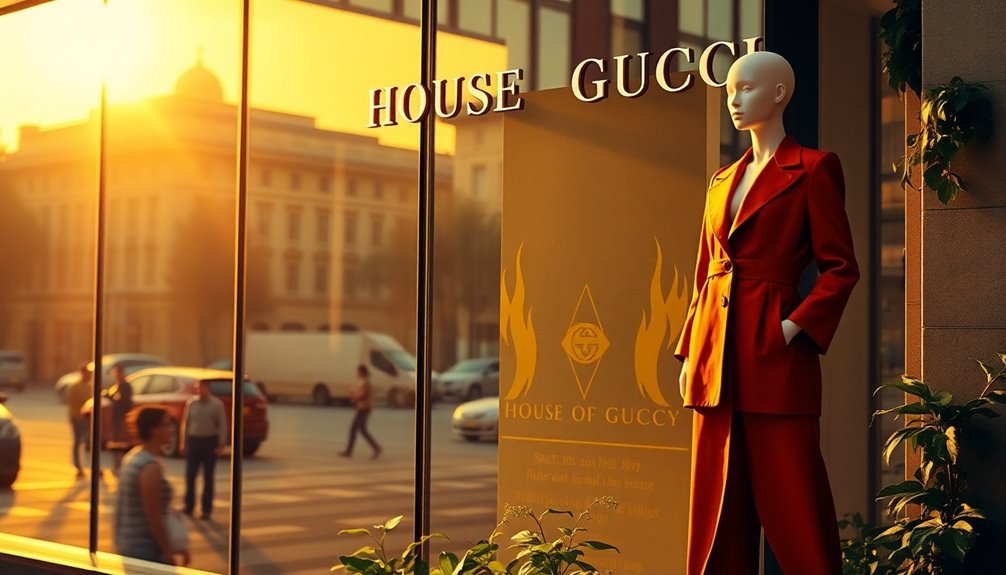House of Gucci stands at a crucial juncture, grappling with a 26% revenue decline and shifting consumer preferences. To revitalize the brand, they're launching fresh product lines and streamlining their distribution. This major revamp might just be the key to their future success, but analysts are skeptical about quick results. As they navigate these changes, the brand must adapt to modern luxury trends. Discover more about Gucci's strategy and its potential impact on the luxury market.
Key Takeaways
- Gucci faces a significant revenue decline, necessitating a strategic revamp to regain market position and consumer trust.
- Shifting consumer preferences and economic uncertainty require Gucci to innovate and align with modern luxury trends.
- The brand's major revamp focuses on introducing new product lines and streamlining wholesale channels to attract consumers.
- Analysts express skepticism about a quick turnaround, indicating slow recovery and the need for long-term repositioning efforts.
- Gucci's future success depends on effectively responding to current market challenges and aligning with evolving consumer expectations.

As Gucci faces a steep decline in revenue, you might wonder how the iconic brand can navigate these turbulent waters. In the third quarter of 2024, Gucci reported €1.6 billion in revenue, down 26%. The decline has been particularly hard on its directly operated retail network, which saw a 25% drop in sales, primarily due to challenging market conditions in Asia-Pacific.
The wholesale revenue took an even steeper hit, plummeting by 38%, signaling a need for strategic streamlining. Gucci's performance accounts for nearly 70% of Kering's EBIT, its struggles have a direct impact on the parent company's overall performance. You can't ignore the shifting consumer preferences and economic uncertainty that are affecting luxury spending. Consumers are more aspirational, but they expect brands to adapt quickly to changing dynamics.
Gucci's brand image needs elevation to stay relevant, as competition intensifies. To tackle these challenges, Gucci is undergoing a significant revamp, particularly in its Leather Goods category, introducing fresh product lines. The brand is also streamlining its wholesale distribution channel, aiming for a more focused approach.
New leadership is set to guide these strategic initiatives, with hopes of aligning Gucci with modern luxury trends. This revamp is essential for building a foundation for sustainable growth while keeping costs in check.
However, the future outlook remains cautious. Analysts at UBS express skepticism regarding Gucci's ability to turn things around by 2025, projecting a 1% contraction in sales. Retail sales are expected to stagnate, indicating that recovery will take time.
You'll need patience as the brand works on long-term repositioning efforts that, while necessary, are unlikely to yield immediate financial gains.
In this critical moment, Gucci stands at a crossroads, and its response will determine its future in the competitive luxury landscape. Can this major revamp be the key to its survival? Only time will tell.
Frequently Asked Questions
What Inspired the Original House of Gucci Brand?
The original House of Gucci was inspired by Guccio Gucci's experiences as a luggage porter at The Savoy Hotel in London, where he learned about luxury.
His vision focused on creating high-quality leather goods, catering to the wealthy elite in Florence.
The brand initially specialized in saddlery, but Guccio's innovative spirit led him to expand into other luxury items, establishing Gucci as a symbol of elegance and craftsmanship in the fashion world.
Who Are the Key Figures in House of Gucci's History?
In Gucci's rich history, key figures shaped its legacy and direction.
You've got Guccio Gucci, the visionary founder, Aldo Gucci, who expanded it globally, and Maurizio Gucci, who faced internal battles.
Then there's Tom Ford, who modernized the brand, and Patrizia Reggiani, whose actions sent shockwaves through the family.
Each played a role in defining Gucci, creating a tapestry of influence that still resonates today.
Their impacts are woven into the brand's identity.
How Has the Brand Evolved Over the Decades?
Over the decades, you've seen Gucci evolve from a small leather goods shop in Florence to a global luxury powerhouse.
The brand embraced innovation with iconic products like the bamboo-handled bag and the Gucci loafer.
Following family feuds, it revived its image under Tom Ford, blending modernity with tradition.
Today, you admire its bold designs and cultural impact, as Gucci continues to push boundaries in the fashion industry while maintaining its prestigious heritage.
What Are the Main Challenges Facing Luxury Fashion Brands Today?
In a world where luxury feels increasingly like a fleeting dream, you're witnessing luxury fashion brands grapple with numerous challenges.
Sluggish growth, shifting consumer preferences, and economic uncertainties weigh heavily on their future. Younger shoppers crave authenticity and value, while older demographics, once ignored, demand recognition.
With the Chinese market stalling and inflation looming, brands must adapt swiftly or risk fading into obscurity.
It's a critical moment; change isn't just necessary—it's vital.
How Does House of Gucci Compare to Other Luxury Brands?
When you compare "House of Gucci" to other luxury brands, you'll notice different strategies at play.
While brands like Dior and Chanel effectively reshape narratives through documentaries, Gucci's approach feels more distant. Its portrayal in the film contrasts sharply with its current inclusive values.
Meanwhile, competitors like Louis Vuitton and Hermès rapidly recover post-pandemic, showing Gucci faces unique challenges in re-establishing its image amid historical controversies and evolving consumer expectations.
Conclusion
As House of Gucci stands at a crossroads, it's time to embrace transformation, to ignite creativity, and to reconnect with its roots. Revamping the brand isn't just about change; it's about revitalizing its legacy, rekindling passion, and reimagining its future. When you choose innovation over stagnation, you choose growth over decline. The path forward is clear: adapt to the times, honor the past, and inspire the next generation. Your journey toward greatness begins now.










